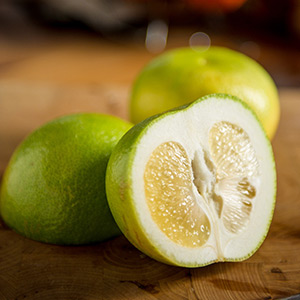- Strawberries
- Cook With Apples
- Grapes
- Grapefruit
- Lemons
- Cabbage
- Asparagus
- All About Bulb Vegetables
- All About Cruciferous Vegetables
- Squash
- All About Root Vegetables
- The Gift of Spice
- Thyme
- Basil
- Raspberries
- All About Tuber Vegetables
- Marjoram / Oregano
- Lemongrass / Citronella
- All Our Fruits, Vegetables and Fresh Herbs
- All About Exotic Fruits
- All About Legumes
- Cooking Pears: Three Inspirational Methods
Oroblancos
All About Oroblancos

The oroblanco is a cross between the grapefruit and the pomelo. It was created and patented by scientists at the University of California Riverside.
Characteristics:
The oroblanco is slightly larger than a grapefruit but has fewer seeds. When ripe, its thick rind is bright green or gold in colour. The oroblanco lacks the bitterness of grapefruit and is surprisingly sweet.
Tips and Advice

- Choose firm oroblancos that are heavy for their size and have slightly shiny skin that is free of spots and bruises.
- Eat an oroblanco as you would a grapefruit or pomelo. Cut it in two and eat it with a spoon, or peel it and divide it into segments like an orange.
- To really appreciate the pleasant sweet flavour of the oroblanco, take it out of the refrigerator and leave it at room temperature for several minutes before eating.
- Cut oroblancos into segments and add to salads or make fruit salad.
- To make oroblancos easier to peel, remove some of the skin and place the fruit in the refrigerator. The cold temperature will cause the white pith to contract and harden so it’s easier to remove.
Expert Tip
For a delicious dessert, warm oroblanco segments for a few minutes and add a splash of Pernod.
Availability
The oroblanco is available in your Metro supermarket from September to December.
Nutritional value
Like other citrus fruits, the oroblanco is a good source of vitamin C.
Storage
Oroblancos can remain at room temperature for about one week. For longer storage, place them in the fruit compartment of your refrigerator.













